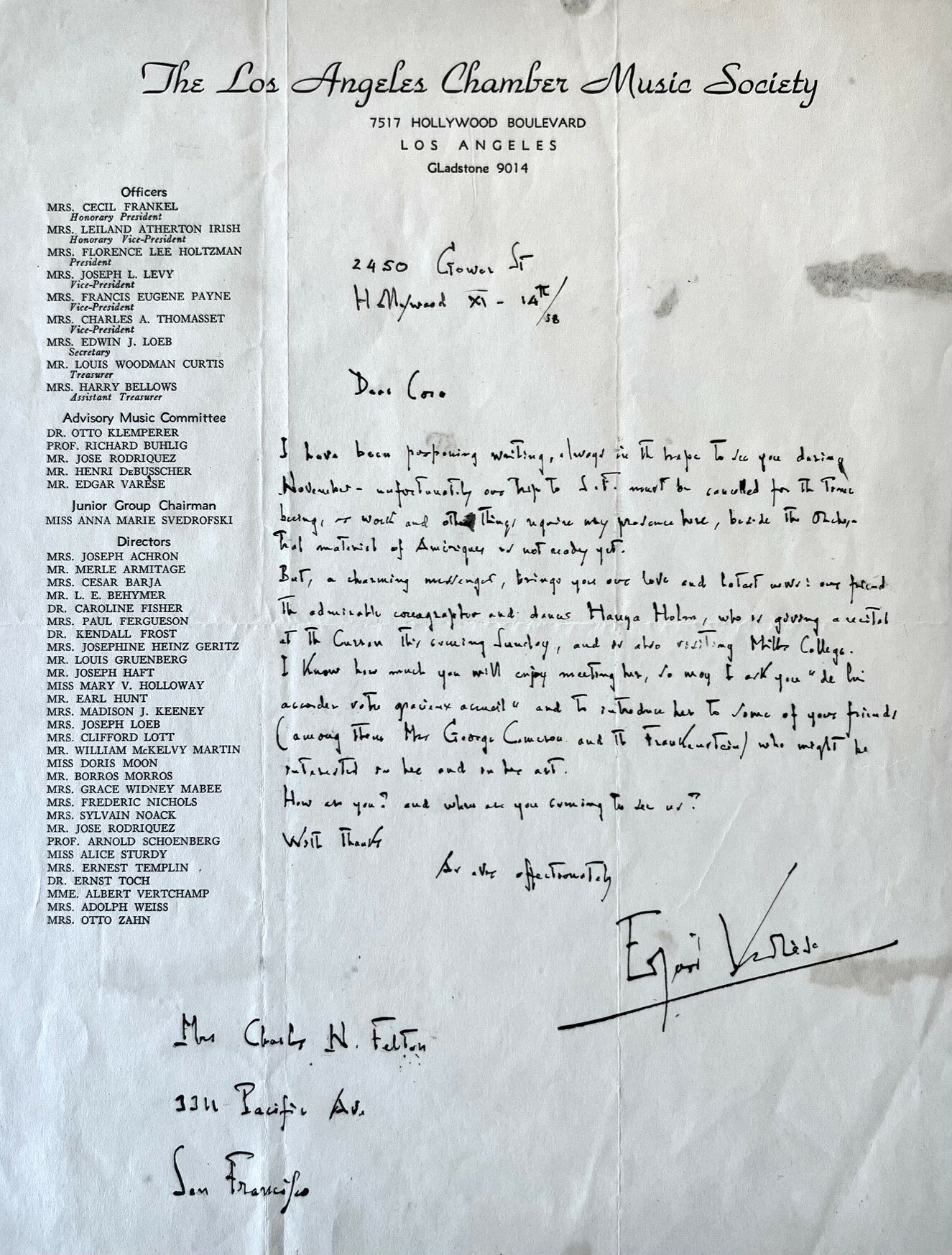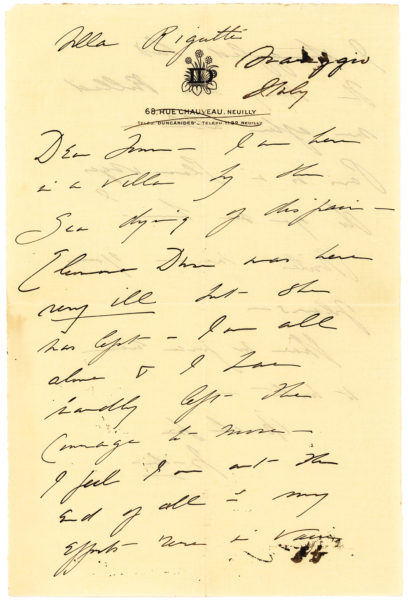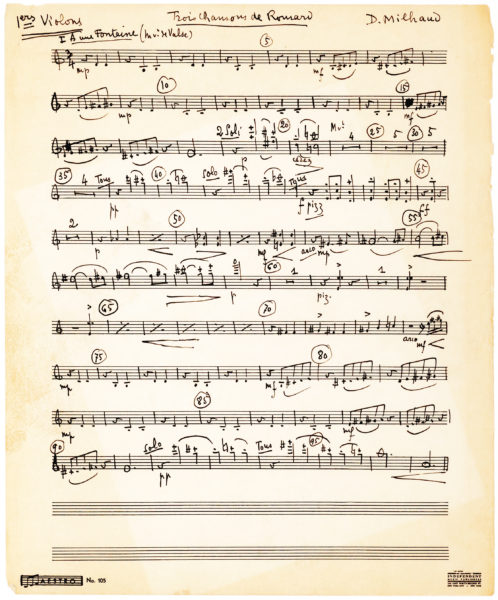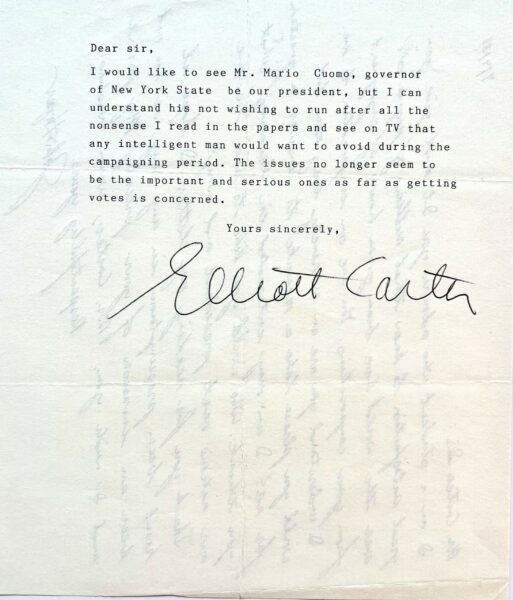But, a charming messenger, brings you our love and latest news: our friend the admirable coreographer [sic] and dancer Hanya Holm, who is giving a recital at the Curran this coming Sunday, and is also visiting Mills College. I know how much you will enjoy meeting her, so may I ask you ‘de lui accorder votre gracieux accucil’ [to grant you your gracious welcome] and to introduce her to some of your friends (among them Mrs. George Cameron and Mr. Frankenstein) who might be interested in her and in her art.
How are you? And when are you coming to see us?…”
A first cousin of French pianist Alfred Cortot, Varese studied composition under Charles-Marie Widor at the Paris Conservatoire beginning in 1904. However, in 1915, early in his musical career, Varese relocated to the United States, where he developed a new genre of electronic music. Our letter mentions Ameriques, his first work composed in the United States (and one of his earliest extant works as most of Varese’s manuscripts from this period were destroyed in a warehouse fire). Completed in 1921, the original score for Ameriques included 13 percussionists playing such “instruments” as a wind machine, sirens and boat whistles, meant to capture the sounds of New York City. During the mid-1930s, Varese left New York for several positions in the West, including Santa Fe, San Francisco and Los Angeles, during which time our letter was written. He returned to New York in late 1938.
German-born dancer and choreographer Hanya Holm (1893-1992) was a pupil of German expressionist dancer Mary Wigman, becoming a teacher at the Wigman School in Dresden before Wigman sent her to New York in 1931 to launch a branch of the school. In 1934, together with three other prominent American choreographers, Martha Graham, Doris Humphrey, and Charles Weidman, Holm helped launch Bennington College’s School of the Dance. Two years later, she established the Hanya Holm Dance Company and Wigman’s New York outpost was renamed the Hanya Holm Studio. Additionally, Holm established the Colorado Springs Center of Dance in the West and choreographed such broadways shows as Kiss Me, Kate; My Fair Lady; and Camelot. Her first major work, Trend, “a landmark in the progress of the modern dance toward the development of its own theatre form,” with music by Wallingford Riegger and Varese, debuted in 1937, the year prior to our letter, (“The Dance: Hanya Holm,” The New York Times, Martin, January 2, 1938). Our letter regarding a November 20, 1938 performance at San Francisco’s Curran Theatre was likely a performance of Holm’s Dance of Work and Play.
Felton was a member of the San Francisco Opera Association, the San Francisco Symphony Association, San Francisco Federation of the Arts, the San Francisco Society of Women Artists, and the San Francisco Art Association. Her patronage of the arts included close personal relationships with “painters, musicians, sculptors, poets, and writers [who] were her house guests and received her encouragement and her wisely given aid,” (“Cora Smedberg Felton, 1874-1941,” California Historical Society Quarterly, Spencer). She was also instrumental in the conservation of Yosemite National Park and San Francisco’s open spaces.
Helen de Young Cameron (1883-1969), the wife of San Francisco Chronicle publisher George T. Cameron, referred to in her obituary as the “Grande Dame of San Francisco,” played the harp and saxophone, held musical performances in her lavish home, served as director of the San Francisco Symphony Association and the San Francisco Opera Association, and “was a leader in the cultural, philanthropic and social life of San Francisco for more than six decades,” (“Mrs. George T. Cameron Dead; Grande Dame of San Francisco,” The New York Times, July 4, 1969).
San Francisco Chronicle music and art critic Alfred Frankenstein (1906-1981) penned program notes for the San Francisco Symphony, taught at Mills College and Berkeley, and served as curator of American art at San Francisco’s M.H. de Young Museum, founded by Helen Cameron’s father.
Folded and creased with some minor spotting. Varese letters, particularly with content, are very rare.





